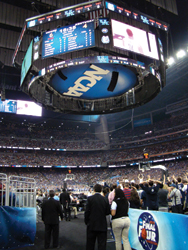 |
Consultant Coffeen Fricke used acoustic noise canceling technology at Reliant Stadium in 2011 to improve the on-court audio.
Photo by: COFFEEN FRICKE & ASSOCIATES
|
The familiar sounds of the Final Four are those of squeaking sneakers and the swoosh of the nets, but three years after moving the men’s event to a center-court configuration in football stadiums to increase capacity, NCAA officials continue to fine-tune acoustics to accommodate fans, the tournament, CBS and the players on the court.
Final Four acoustics consultant Coffeen Fricke & Associates produces an audio effects feed that picks up the sounds of the game — like the sneakers and nets — and sends them through the stadium’s in-house sound system so that they can be heard in the stadium’s upper reaches.
“The NCAA is interested in making it feel like a more intimate venue than it actually is,” said Stephen Solberg, a senior associate at Coffeen Fricke.
The consultant was also hired in part to provide a high-quality experience for Final Four attendees paying as much as $400 on the primary market to sit on event-level bleachers sloping back from the court, said L.J. Wright, the NCAA’s director of championships, alliances and operations.
“We had to do something to get more floor coverage because we were putting fans farther out on the field with prime ticket holders sitting in those seats,” Wright said. “The first year, we tried different things with the way we miked the floor and near the goals to pick up sounds.”
But attempts to augment on-court sounds at the 2009 Final Four at Detroit’s Ford Field backfired, forcing the consultant to shut its feed down halfway through the event. The challenge revolved around echoes that reverberate inside the big stadiums, where loudspeakers hang 40 feet above the court and microphones plugged in at event level capture the sounds of the game.
“It proved to be very distracting for the players, like with free throws when they would bounce the ball a couple times and then a few seconds later, they would hear the ball bouncing again from the sound system,” Solberg said. The echoes can also interfere with the public address system and the CBS broadcast.
After the issue arose again at Indianapolis’ Lucas Oil Stadium in 2010, Coffeen Fricke tapped into a new technology called acoustic echo canceling, commonly used for teleconference calls in small boardrooms. It identifies two audio signals and separates the first signal from the second one during the same transmission.
The technology enables Coffeen Fricke to broadcast the effects it picks up on the court through microphones shared by CBS and subtract the public address announcer’s voice before those sounds go through the loudspeakers. Most important, it eliminates the echoes that can disrupt the broadcast, the public address system and play on the court.
The consultant has used the technology in arenas, but not to the extent that it is used during the Final Four, Solberg said. It was employed at the 2011 Final Four at Reliant Stadium in Houston and will be brought back for next month’s Final Four at the Mercedes-Benz Superdome in New Orleans.
Biamp Systems, a Beaverton, Ore., tech firm, provides the technology free to the consultant and the NCAA. It is stored in a small box set up on a desk about 30 yards from the court, plugged into the small mixing console and microphones operated by the consultant.
“When we took this device to Houston last year, it was really an experiment to see if it would work, and it did end up working very well,” Solberg said. “CBS was very happy with the end results.”
CBS officials declined to comment on the new system.
“The testing of the technology has gotten to the point that we understand it,” Wright said. “It’s a good product.”




